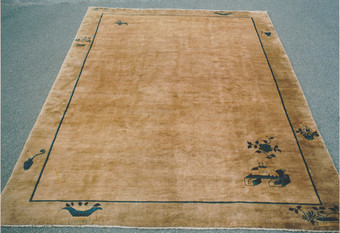Antique handmade oversized carpet No. 58235 Chinese, ca. 1920 China 490 x 330 cm

Larger images (will open in new window)
Please click on the thumbnails below for a larger view
| main view |
 |
| Item Number: |
58235 |
| Name: |
Chinese, ca. 1920 |
| Country of Origin: |
China |
| Size: |
490 x 330 cm |
| Made:
|
ca. 1920 |
| Pile: |
wool |
| Design: |
floral / allover |
| Ground Color: |
brown |
| Remarks: |
This is a unique handmade / hand-knotted / traditional oriental carpet
The pile of this carpet is made of wool |
 add to cart
add to cart
More about the provenance Chinese, ca. 1920 | China
The art of Chinese carpet making can look back on a highly developed ancient culture. Chinese artists and craftsmen have achieved greatness in China as well as other Oriental countries to which they have been called by art-loving rulers and princes. Their influence on the art of carpet making is indisputable. Carpet making in comparison is a rather young Chinese art. In the 17th century Chinese carpet making has been encouraged by the Chinese emperor K'ang-hi. The dragon motif is one of the typical and characteristic motifs of traditional Chinese rugs. Many of the Chinese rugs of today are being relief-cut and shine-washed (only first class chrome colors are being used). Altogether one can say that Chinese rugs are very elegant rugs with an ancient very characteristic tradition.
The wool of this rug has been dyed with vegetable dyes only which became very rare in Oriental rugs. Since ca. 1850 synthetic dyes found their way into carpet production. Ever since they replaced natural vegetable dyes more and more also due to the fact that the production of vegetable dyes is very time consuming and difficult. But the "aura of genuineness" can be reached to its full extent with vegetable dyes only. Vegetable dyes are made from leaves, flowers, branches, fruits and roots. They give Oriental rugs a particularly harmonic look. In general Oriental rugs "age" better and more beautifully with vegetable dyes than with synthetic dyes plus they increase a carpet's value. Most of today's production is made with synthetic dyes which makes this rug an even more desirable piece. Unfortunately many rugs in the market are being labelled as being vegetable dyed which in many colors is simply not true which damages the reputation of the carpet industry altogether.

